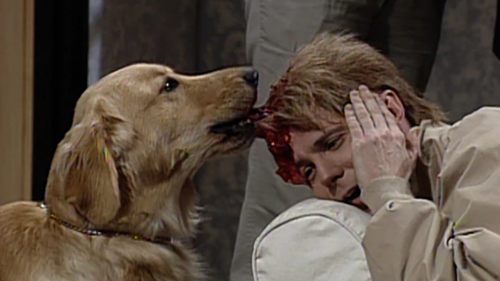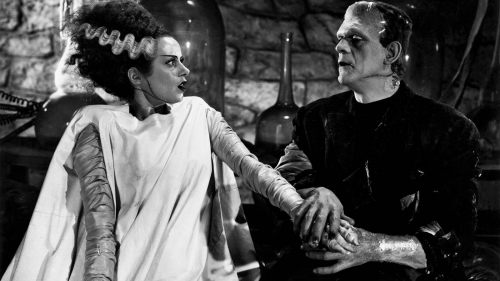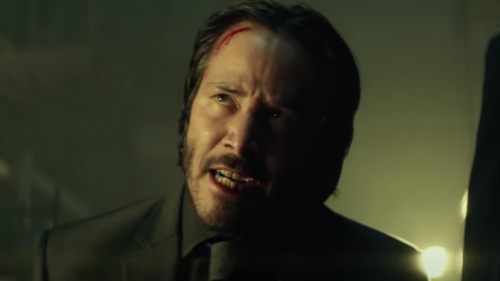Our Faithful Fathers: CLOSE ENCOUNTERS OF THE THIRD KIND At 40
We want to believe.
Staring up at the sky, searching for any signs of Intelligent Life, human beings have long put their faith in the notion that something is up there, looking down at us with interested eyes. It may be a God, or some sort of spiritual hand, guiding us along in our day-to-day; or, at the very least, acting as an invisible safety net when things aren’t going so great. Others pray for visitors from beyond the stars, touching down in their advanced craft and (hopefully) delivering enlightenment that mankind has yet to achieve. These Fox Mulders are trading in religious symbolism for UFOs – the truth regarding intergalactic communication hidden in the cosmos’ blackness that’s only visible once the sun goes down.
Steven Spielberg is one of these true believers. While the young director was raised on Jewish dogma, he spent years clipping mentions of UFO sightings from newspapers, interviewed military men who believe the government covered up contact with visitors from other galaxies, and became close associates with extraterrestrial experts such as J. Allen Hynek, who developed the “Close Encounters” classification system Spielberg’s third feature film drew its title from. Like his friends from the filmmaking community – such as Martin Scorsese and Brian De Palma – Spielberg drew from his odd obsessions to craft his next piece of cinema, resulting in what many still consider his defining masterpiece.
Close Encounters of the Third Kind (’77) is Spielberg’s follow up to Jaws (’75), and the main difference between the two can be felt in the way both films treat their respective “father figures”. Chief Martin Brody (Roy Scheider) becomes the protector of not only his own unit, but the whole of Amity Island, once he jumps on the Orca with Quint in order to hunt down the great white beast using his newly appointed police post as its personal buffet. Brody is, in some ways, the prototype for many of the male leads that would dominate the rest of Spielberg’s filmography. From Dr. Grant (Sam Neill) in Jurassic Park (’93), to Ray Ferrier (Tom Cruise) in War of the Worlds (’05), Spielberg has returned to stories revolving around male protectors, especially of children. Even his lauded historical epics (such as Schindler’s List [‘93] and Saving Private Ryan [‘98]) have concluded on notes with men wondering if the deeds they performed during their lifetimes (in the name of saving or being saved by others) deemed them worthy of redemption (ultimately in God’s eyes). Never forget, it’s Chief Brody’s witnessing of his son’s near fatal encounter with a killer shark that finally causes him to forgo his fear of water and dive headfirst into his pursuit of the marauding nautical beast.
This devotion to personal and spiritual responsibility is why Close Encounters is such an anomaly in Spielberg’s filmography, as it follows a man who literally abandons his wife and children to pursue his own obsessions. Spielberg himself has labeled his initial filmic foray into alien invasion a “privilege of youth”, and admits he’d never be able to make the same movie now that he has a family of his own. While investigating a series of electrical outages, Indiana lineman Roy Neary (Richard Dreyfuss) – a suburban father of three agitated by his lot in life – experiences a close encounter with a UFO, which flies over his truck and singes the side of his mug. This sets off a cataclysmic chain reaction in Roy’s life, as he becomes fascinated by flying saucers, and crafts models of mountains that now haunt his dreams. His wife (Teri Garr) eventually takes their three kids away from the increasingly erratic man, but Roy doesn’t care, as his quest will deliver him to Devils Tower in Moorcroft, Wyoming (the picture’s iconic locale, where the Drafthouse recently held an outdoor Rolling Roadshow screening), where Roy meets Jillian (Melinda Dillon), a fellow Hoosier who saw her three-year-old son abducted by aliens.
Spielberg’s tinkered with the edit of Close Encounters now on two separate occasions throughout his career (once in ’80, and again in ’97), each slight rejiggering casting a more disparaging eye on Dreyfuss’ reckless papa. But the believer’s neglect is still ultimately the narrative’s main thrust, despite whatever new or old material is added/reshaped. Part of the reason for these “Director’s Cuts/Special Editions” (which Spielberg performed before Ridley Scott cemented them as commonplace with his Blade Runner [‘82] re-workings), is that the production of Close Encounters was (like Jaws before it) incredibly troubled. The young auteur had a cash-hungry Columbia Pictures breathing down his neck, hoping to have the film finished in time for a Christmas ’77 release. Though he’s the sole screenwriting credit, Spielberg had input from several scribes (including Taxi Driver’s [‘76] Paul Schrader* and Alien’s [‘79] David Giler) during the film’s long development period. Close Encounters went way over budget and shot longer than scheduled, reportedly because Spielberg would stay up all night during production, watching movies and penning new scenes that’d be scheduled to shoot the next day.
The Special Edition (which saw Close Encounters re-released in theaters August ’80) fleshes out Roy and his family best, as we see that his new preoccupation with these potential visitors doubles as an excuse to leave the family he was already growing weary of. Though he lives in a suburban home (nestled in amongst rows of identical domiciles), the inside of Neary Castle is a wasteland of clutter, as three kids have run rampant and made it a dumpster pile of forgotten toys. The family communicates through a series of barks and overlapping conversations, as Ray attempts to extoll the virtues of Pinocchio (to no avail), and mentally check out with his own set of toy trains. Whether he consciously recognizes it or not, Devils Tower is already calling to the father; a droning hum of domestic displeasure becoming the only soundtrack he recognizes upon waking each morning. He needs anything to disrupt these chaotic humdrums of the life he’s chosen, and the little grey men become avatars for a higher calling that may, in all actuality, just be a bullshit justification for absenteeism.
The historic success of Jaws (essentially creating summer blockbuster culture as we know it today) meant that Columbia allowed Spielberg to make any movie he desired. So, the writer/director took his original concept (based around decades-spanning studies conducted during by the US Air Forced dubbed “Project Blue Book”) and melded them with recreations of scenes from his amateur $500 sci-fi feature, Firelight (’64). But just how Brian De Palma would chase the ghost of his philandering surgeon father for a significant portion of his career**, Spielberg psychically integrated his own troubled relationship with his dad into Close Encounters. While his mother nurtured young Steven’s artistic interests, his father was emotionally distant, and often didn’t comment on his kid’s work until his coworkers noted seeing some of his early films at a local theater. Following his parents’ separation, the director didn’t talk to his dad for fifteen years, and that patriarchal void can be felt in the number of truant or surrogate male role models that’ve dominated his work throughout the years. Roy Neary could essentially stand in for Arnold Spielberg – a man who simply vanished into the ether, leaving his son to wonder where the hell he’d disappeared.
Being a Spielberg picture (and despite the rather tumultuous production), Close Encounters sports some of the most technically impressive filmmaking of the New Hollywood era, most of which results from the auteur’s own obsessive devotion to cinema itself. Douglas Trumbull was hired as effects supervisor, mainly because Spielberg found his work with Stanley Kubrick on 2001: A Space Odyssey (’68) to be a borderline religious experience unto itself. Vilmos Zsigmond (who was aided by a veritable murder’s row of photographers during production) adds a lush, expansive visual palate to Close Encounters, presenting Spielberg’s vision of the world as a sprawling, softly lit tapestry, accented by John Williams’ gorgeously bombastic score (five tones of which are utilized to converse with the aliens). Perhaps the most inspired decision was casting François Truffaut as Claude Lacombe, the French scientist in charge of UFO monitoring within the United States. Acting in his only English language role (not to mention the only character from a film Truffaut did not direct himself), the New Wave maestro’s presence is a clear signifier of the deep humanism Spielberg was trying to convey; a natural byproduct of being a cinephile student of works like The 400 Blows (’59).
However infatuated and influenced by both the practice of Judaism and the potential existence of extraterrestrials, Spielberg’s ultimate devotion is to the wonders of cinema itself. Close Encounters of the Third Kind was manufactured to produce awe; not just in its breathtaking visuals, but also by conveying the notion that the medium could be used to reproduce the dreams of anyone brave enough to step behind the camera. Movies are tools of faith, and Spielberg’s utilized them throughout his career to establish his disdain for both the dad he had, and love for the ones he always desired. The familial unit’s a primary focus for his lens post-Encounters, as his other alien adventures (such as ET [‘82]) saw foreign beings helping to unite families, just as Close Encounters showed them splitting one up. Spielberg channeled his own grief regarding the abandonment he felt into Roy Neary, but then spent a solid portion of his lifetime representing the optimism that not all parental figures were that callous and self-consumed. Pop art helped him exorcise the demons his dad left him with, while creating fictitious avatars to take his place, and provided hope for those who’d experienced a similar childhood that not all was lost when weak mean walk out the door.
*Whose initial script, Kingdom Come, was labeled “one of the most embarrassing screenplays ever turned in to a major film studio or director” by Spielberg.
**Most notably in Dressed to Kill (’80), where Keith Gordon plays a science nerd fictionalization of BDP.
Close Encounters of the Third kind is currently playing at Drafthouses across the country in a brand new beautiful 4K restoration. Get your tickets here.



